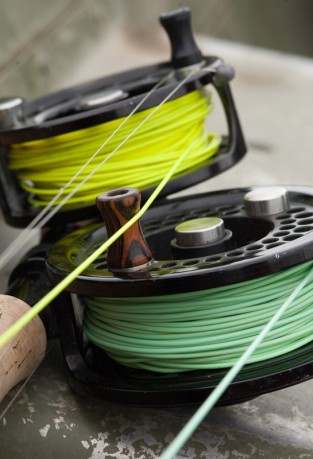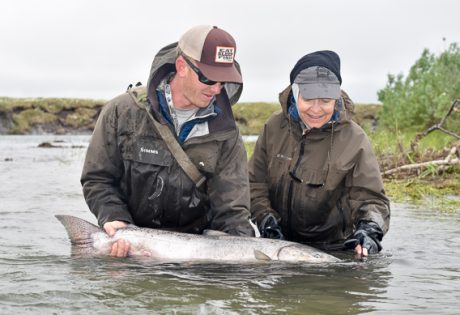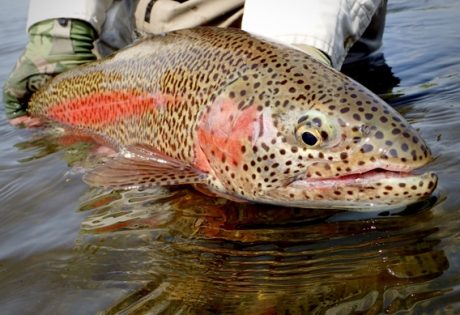
During the summer, Alaska is a hotbed of fly anglers. Many are new to Alaska and have only fished with a five-weight in spring creeks and tailwaters of many incredible streams and rivers in the lower Forty-Eight.
One question we get a lot about coming to Alaska for fly fishing is, “if I were only to bring one rod, what should I bring,” to which we answer, “bring two.” From the adventurous traveler who will explore and fish all across Alaska for a month to the fly-out lodge guest anticipating a week of epic fishing, they all want to try and get away with bringing one rod for their trip. We get it. You want to pack light, and it’s easier to take one fly rod set up, save space, less weight, etc. Or fly fishing equipment is not cheap, and you don’t want to spend a lot of money. Both are good arguments. That being said, taking one fly rod setup to Alaska is like taking only a Five Iron to play The Masters at Augusta. Can you do it? Sure, but it’s not wise. When coming to fish Alaska, you should bring, at the very least, a six-weight setup and an eight/nine weight setup. That will cover most fly fishing experiences in Alaska.


Regardless of the type of fishing adventure you’re going to be on or the length, having at least two fly rod setups is ideal for at least two reasons:
- Alaska’s fishing season has both Big Fish and “smaller” fish at any one time.
- If you, for whatever reason, break a rod, at least you’ll have another setup as a backup.
Let’s examine reason one. In Alaska, at any point during the fishing season, you have a mix of “smaller” Trout, Grayling, Dolly Varden, and Char throughout the state. We say they are “smaller” fish, but in Alaska, even the “smaller” fish are big, making a six-weight fly rod setup ideal. Then, depending on the time of the season, Kings Salmon, Chum Salmon, Sockeye Salmon, Coho Salmon, and Pink Salmon will run throughout Alaska’s rivers. These Salmon are bigger and require a rod with more backbone; hence an eight or nine-weight fly rod is ideal. Between the two fly rod setups, you can cover most of the fish you encounter in Alaska.
Reason number two is best explained with a story. Once upon a time, a young, ambitious fly angler had a dream to fish all across the state of Alaska for a month. We’ll call him Jim. Jim finally decided it was time and started planning his trip. After many months of planning, mapping, scheduling, and preparing, Jim plotted his roadside adventure to fish and catch all of the fish you can catch in the rivers in Alaska with a lone five-weight rod. Jim was ready. Jim flew up to Alaska, and his adventure was afoot. Jim rented a vehicle and went North to catch Rainbows and Dolly Varden. On day one, Jim found another spot, fished, and had great success with his lone five-weight fly rod. Jim continued North to all the other sites based on information he obtained from old Sourdoughs and guides. Three days into his month-long trip, Jim found him at a spot where the river was larger and full of fish. Excited, he cast his five-weight into the river. All of a sudden, he had a fish on. He hooked a big fish. He didn’t know what it was. Seconds into this rodeo, Jim knew he was overpowered. Albeit a seasoned angler, Jim had never experienced this much brute force and didn’t know how to manage. One minute in, his lone five-weight exploded like a firecracker, and the big fish he never saw broke off. To much his chagrin, Jim was devastated because the only fly rod set up he brought broke. He was in the middle of Alaska, hours away from civilization, with a broken fly rod.
Have at least two fly rod setups if you’re coming to Alaska. A six-weight fly rod and an eight or nine-weight fly rod will cover most of any fishing adventure you will encounter in Alaska. And, in case you break one, although it may not be ideal, at least you’ll have another rod to fish. Don’t be like Jim.
If you’d like more information on fly rod setups for Alaska, check out Mossy’s Fly Shop page on Fishing Alaska. It provides information on all the rod and reel configurations you’ll need for Alaska fish. Click Here for the Fly Rod Setup.
Other Tips on Fishing Alaska:
Leave a Reply